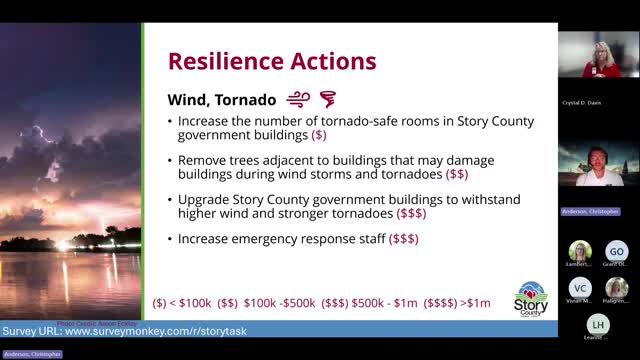Story County Government Implements Strategies for Extreme Weather Preparedness and Sustainability
October 01, 2025 | Story County, Iowa
This article was created by AI summarizing key points discussed. AI makes mistakes, so for full details and context, please refer to the video of the full meeting. Please report any errors so we can fix them. Report an error »

During a recent public meeting in Story County, Iowa, officials discussed strategies to enhance the county's resilience against extreme weather events, a key component of the Story County Climate Action Plan. The meeting highlighted various approaches to mitigate the impacts of severe storms, heat waves, and winter blizzards on government operations and community services.
One significant topic was the need to fortify government buildings against stronger wind loads and potential tornadoes. Officials proposed tree removal near buildings to reduce damage risks during windstorms, alongside upgrading structures to withstand harsher weather conditions. While these upgrades are expected to incur higher costs, they are deemed necessary for long-term safety.
The meeting also addressed the increasing frequency of summertime thunderstorms. To improve emergency response capabilities, officials suggested increasing staffing levels, either through permanent hires or temporary positions during peak summer months. This proactive measure aims to ensure that the county can effectively respond to emergencies as they arise.
In terms of winter storm preparedness, the discussion included options for maintaining essential services when travel becomes hazardous. One proposed solution is to enable remote work for staff, allowing them to provide services online when conditions prevent them from reaching the office. This approach is seen as a cost-effective way to ensure continuity of services, although it may not be fully effective in all situations.
The meeting further explored strategies to combat heat-related illnesses during extreme temperature days. Suggestions included increasing tree canopies around county facilities to provide shaded areas for cooling and establishing designated cooling centers equipped with fans and ice. Additionally, officials discussed the potential for remote work during excessively hot days, similar to winter protocols.
To address energy consumption during heat waves, the county is considering implementing high-reflective surfaces around buildings and window coatings to reduce heat absorption. Enhancing the energy efficiency of government buildings was also emphasized as a way to alleviate pressure on the electrical grid during peak usage times.
Finally, the meeting concluded with a shift in focus from weather impacts on operations to the environmental effects of county government activities. This transition underscores the importance of considering both resilience and sustainability in the county's climate action efforts.
As Story County moves forward with its Climate Action Plan, these discussions reflect a commitment to adapting to climate challenges while ensuring the safety and well-being of its residents. The next steps will involve further evaluation of proposed measures and their implementation in the coming years.
One significant topic was the need to fortify government buildings against stronger wind loads and potential tornadoes. Officials proposed tree removal near buildings to reduce damage risks during windstorms, alongside upgrading structures to withstand harsher weather conditions. While these upgrades are expected to incur higher costs, they are deemed necessary for long-term safety.
The meeting also addressed the increasing frequency of summertime thunderstorms. To improve emergency response capabilities, officials suggested increasing staffing levels, either through permanent hires or temporary positions during peak summer months. This proactive measure aims to ensure that the county can effectively respond to emergencies as they arise.
In terms of winter storm preparedness, the discussion included options for maintaining essential services when travel becomes hazardous. One proposed solution is to enable remote work for staff, allowing them to provide services online when conditions prevent them from reaching the office. This approach is seen as a cost-effective way to ensure continuity of services, although it may not be fully effective in all situations.
The meeting further explored strategies to combat heat-related illnesses during extreme temperature days. Suggestions included increasing tree canopies around county facilities to provide shaded areas for cooling and establishing designated cooling centers equipped with fans and ice. Additionally, officials discussed the potential for remote work during excessively hot days, similar to winter protocols.
To address energy consumption during heat waves, the county is considering implementing high-reflective surfaces around buildings and window coatings to reduce heat absorption. Enhancing the energy efficiency of government buildings was also emphasized as a way to alleviate pressure on the electrical grid during peak usage times.
Finally, the meeting concluded with a shift in focus from weather impacts on operations to the environmental effects of county government activities. This transition underscores the importance of considering both resilience and sustainability in the county's climate action efforts.
As Story County moves forward with its Climate Action Plan, these discussions reflect a commitment to adapting to climate challenges while ensuring the safety and well-being of its residents. The next steps will involve further evaluation of proposed measures and their implementation in the coming years.
View full meeting
This article is based on a recent meeting—watch the full video and explore the complete transcript for deeper insights into the discussion.
View full meeting
